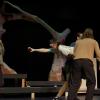
December 21, 2011 - 3:40am
“The arts teach children that problems can have more than one solution and that questions can have more than one answer.”
--Elliot Eisner, former president of the International Society for Education through Art
Tamagawa Garden is a tranquil oasis on Vancouver Island University’s Nanaimo campus that attracts visitors even on soggy, grey winter days.
Education Professor Heather Pastro sees the garden as one of many features of VIU that can open a world of artistic and academic opportunities for students of all ages.
Pastro, a former elementary and secondary school teacher, has kept close ties with School District 68 even though she has been involved in post-secondary education for more than 20 years.
She uses Tamagawa Garden, the 10-metre totem in the Library, the campus branch of the Nanaimo Art Gallery and other sites at VIU to give university students and visiting elementary students an appreciation for the work of painters such as Emily Carr and Claude Monet.
“Using the amenities here at VIU, I am able to provide students with a very rich experience in the arts. I create opportunities and activities for the children to explore the work of famous artists and then to develop their own artistic skills and imagery in the style of those artists,” says Pastro.
“We know that visual art helps children to develop higher level thinking skills such as analytical and critical thinking. With this knowledge, there are so many important reasons to encourage and promote arts experiences for children in our schools.”
Pastro cites “exceptional educators” Elliott Eisner and Howard Gardner who have conducted extensive research in the area of arts education and shown a direct correlation between arts experiences and enhanced student achievement.
“I truly believe that art teachers really need to be their own best advocates for art education, and one of the reasons that I create and promote these opportunities and experiences for children is for them to realize their potential and see different possibilities for themselves.”
Last spring, Pastro invited Grade 6 students from McGirr Elementary School to come to her art room studio on campus to learn about Emily Carr through videos, books and other resources. The children were then given instruction from Pastro on different ways to draw trees. Afterwards the students toured Tamagawa and looked at trees in their natural environment. They later returned to the studio and used the sketches to create paintings in a style reminiscent of Carr’s distinctive work.
“We talked about how she used paint and how she mixed colours. We talked about who Emily Carr was and learn about social justice issues in Canada at the time she painted,” she recalls.
When the paintings were completed Pastro went to McGirr to hang up all of the students’ paintings as well as their tree sketches. The students wrote about their learning experience and added their written commentaries to the display.
“The process is more important than the product and I wanted to hang all of the works up so that students could celebrate their achievement, and recognize all of the learning that went in to the final product,” says Pastro.
Pastro, who is on the executive of the BC Art Teachers Association, believes it is important to expose student teachers to the merits of visual arts even if it is not their primary interest of study.
“Teachers can integrate art into other areas and make the learning much more meaningful,” said Pastro. “People learn in different ways and the arts can be used to accommodate students’ individual learning styles.”
“One of the things we do as art educators is train the eye to really see and look at the world from different perspectives. The arts also celebrate multiple perspectives and teach us that there are many ways to see and interpret the world.”
“A university campus is a valuable resource for a community”, says Pastro, who grew up in Fredericton near the University of New Brunswick. “When university faculty engage with young students, they are introducing them to amazing possibilities.”
“For some of these kids, it’s their first time in a university building, it’s their first time going to an art gallery. These are the kinds of experiences that most students will remember.”
Pastro hopes that exposing students to the VIU campus and providing meaningful arts experiences might motivate them to think further about their own post-secondary education. They might think that attending university isn’t such a daunting or scary thought, and could be something realistic in terms of their own personal goals.
“Very often the teachers of the classes that come to me for these field experiences are graduates of our Teacher Education program, and it’s all the more meaningful for me to have an opportunity to partner with my former students as colleagues in the field. All in all, it is a meaningful and rich experience for everyone and is great advocacy for art education both personally and professionally.”
Tags: In the Community






